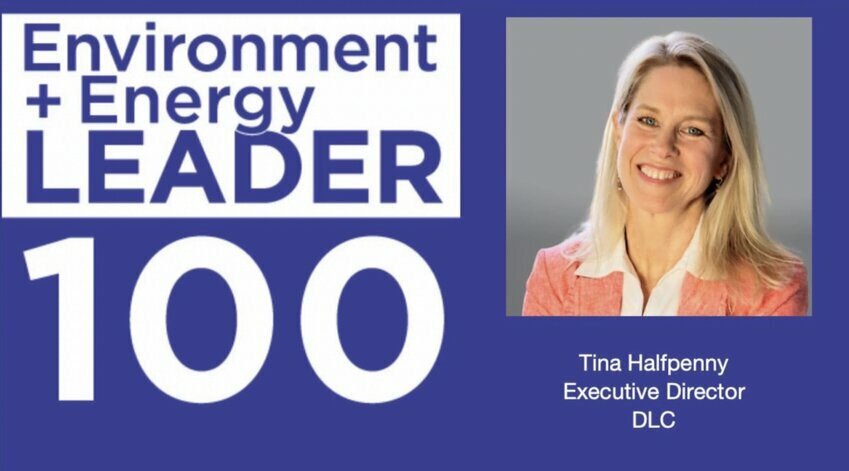 The Environment+Energy Leader Honoree program is an annual list that recognizes the environment and energy “doers” who break trail in creating new solutions, programs, platforms, best practices and products to help their companies – or other companies – achieve greater success in commercial and industrial environment and energy management. Meet the Honorees… is an ongoing series that features Honorees throughout 2022. See the complete list of 2022 Honorees here.
The Environment+Energy Leader Honoree program is an annual list that recognizes the environment and energy “doers” who break trail in creating new solutions, programs, platforms, best practices and products to help their companies – or other companies – achieve greater success in commercial and industrial environment and energy management. Meet the Honorees… is an ongoing series that features Honorees throughout 2022. See the complete list of 2022 Honorees here.
Meet Tina Halfpenny, executive director of DLC, a non-profit organization improving energy efficiency, lighting quality, and the human experience in the built environment. Her role starts with "envisioning what positive impacts we can make on energy use and the environment through energy efficiency and lighting." The vision needs to be translated into business plans and then goals and metrics.
"So much of the work we do depends on buy-in and support from stakeholders and change agents: the administrators of energy efficiency incentive programs, as well as industry, so communication, outreach and engagement are happening every day," Tina says. The range of stakeholders the DLC engages with – from energy efficiency programs to lighting manufacturers, distributors, test labs and more – presents important opportunities for daily collaboration. "My day-to-day includes regular check-ins with my team, our working groups and committees to vet plans, troubleshoot, ideate, build and deliver our programs and policies," she adds.
Tell us about your biggest energy management challenge and how you are addressing it.
Tina Halfpenny: I've been working on market transformation and energy efficiency for 20 years, so there have been many big challenges, as we all know the problem of climate change is vast and variable, and reducing our energy load is paramount to mitigating the crisis. Most recently, and related to energy-efficient lighting, we are addressing the problem of light pollution in a way that maintains the energy savings inherent with LED lighting, but with a focus on light at night.
Light pollution is disproportionately exacerbated in communities of color and a cause of population decline across a myriad of animal species, however LED technology has delivered immense energy savings across the globe and more opportunity remains. We need to design and install our lighting in a more conscientious manner so that we only install the light that we need and direct it where we use it.
My team developed the LUNA program to identify dark sky friendly lighting, however much work is needed for application guidance and awareness of light usage where it affects the nighttime environment so that we continue to reduce our energy load without compromising local ecology such as vital pollinators, migrating birds and nocturnal animals.
What was a successful project or implementation you worked on at your company that you can share? Do you have any tips that would help colleagues at other companies who are contemplating similar projects?
TH: I would again cite the LUNA program for outdoor lighting. We had our internal team of market development specialists, lighting scientists and engineers working towards a specification to mitigate light trespass and sky glow, without compromising on energy savings or visibility of outdoor light. We brought in experts from Pacific Northwest National Labs, the International Dark Sky Association, the Illumination Engineering Society, International Well Building Institute, and recognized lighting designers and researchers to act as advisors.
The policy was released for public comment in two versions and published at the end of 2021. Collaboration and engagement was critical for development and the policy was heavily promoted, distributed and commented on by stakeholders across the municipal, industry, and utility sectors.
What trends do you expect to see in the market in the next few years? What challenges will the industry face and what technologies or organizational changes will overcome them?
TH: With extreme weather and hybrid work plans, the functionality of commercial buildings needs to become more versatile. Lighting and controls should become commonplace with building retrofits and standard code for new construction. The functionality of a room or building system can enhance the work environment and optimize energy use. Training the workforce for specification, design and installation of better lighting and building systems needs to happen quickly. The costs of sensors and software should begin to decrease as adoption grows.
Tell us about a favorite hobby, passion or book you've read recently that has had an impact on you and your work.
TH: During the pandemic, I really got into gardening. We even built a greenhouse. I've been reading books such as Nature's Best Hope, by Doug Tallamy, and Braiding Sweetgrass, by Robin Wall Kimmerer, that emphasize the value of our soil, trees and plants for biodiversity and climate health as well as the important role we play as stewards of the land, whether we have a balcony, a yard, or manage or rent a property. I spend so much time thinking about technology and building science, it's been a great expansion to think about how I use the earth, whether it's through my food choices or my garden's purpose.
What else would you like to add?
TH: I'm happy to be honored here and encouraged by the work of others in this group.
LinkedIn: https://www.linkedin.com/in/christina-halfpenny-967b62b/
Editor’s note: nominations are now open for this year’s E+E Honorees. Nominate a colleague — or yourself — for the 2022 E+E Honoree list today.